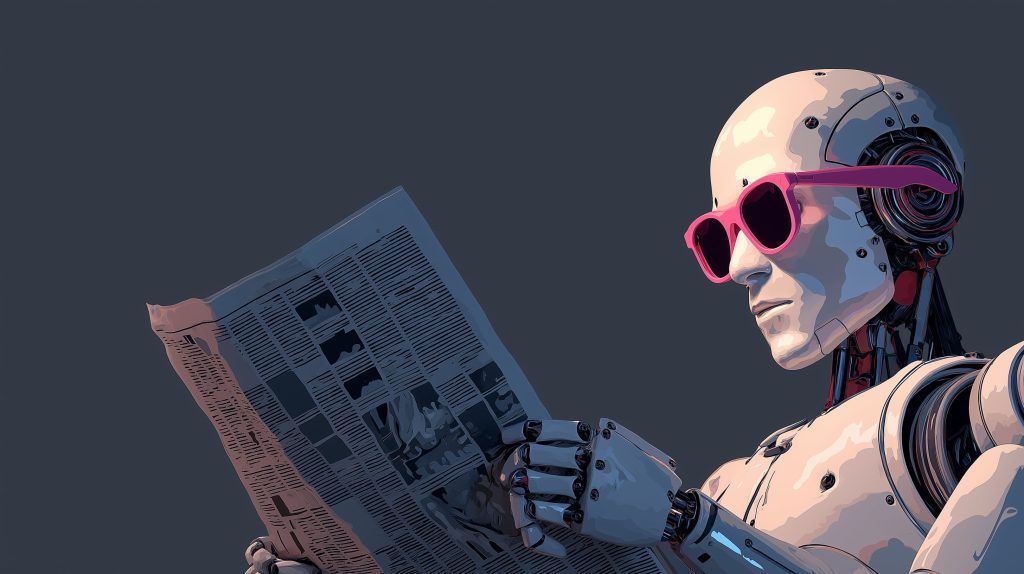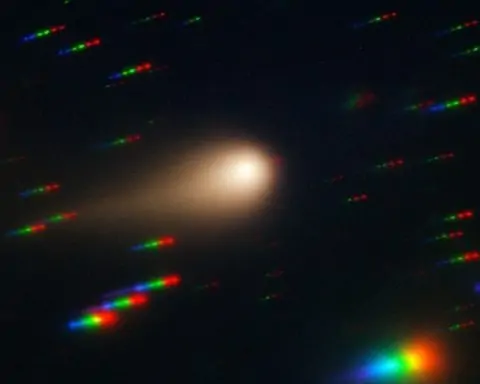Space & Astronomy
- Record-Breaking Black Hole Weighs In: Astronomers have discovered what may be the most massive black hole ever detected – an ultramassive black hole roughly 36 billion times the Sun’s mass – lurking in the distant galaxy known as the “Cosmic Horseshoe” [1] [2]. The behemoth, about 5 billion light-years away, was revealed by the perfect Einstein ring formed as its host galaxy’s gravity warps the light of a background galaxy [3] [4]. By combining gravitational lensing with traditional stellar motion measurements, the team was able to confidently gauge its record size [5]. “This is amongst the top 10 most massive black holes ever discovered, and quite possibly the most massive,” said Professor Thomas Collett of the University of Portsmouth, who noted their new lensing-based method provides far more certainty in the mass estimate [6]. The finding, published in Monthly Notices of the RAS, pushes the known limits of black hole size and will help scientists understand the link between galaxies and their central black holes [7] [8].
- Closest Sun-Like Star May Host a Planet: Using NASA’s James Webb Space Telescope (JWST), scientists found strong evidence of a new exoplanet orbiting Alpha Centauri A, the nearest Sun-like star at just 4 light-years from Earth [9] [10]. Webb’s mid-infrared instrument captured an image of the Alpha Centauri system with a coronagraph mask blocking the star’s glare, revealing a faint source about 1–2 AU (roughly twice Earth’s distance from the Sun) from Alpha Centauri A [11]. Based on its brightness and orbit simulations, researchers say the object is likely a gas giant about the mass of Saturn circling in an elliptical path within the star’s habitable zone [12]. If confirmed, the planet would be the closest directly imaged planet to its star ever seen – and the closest to our own solar system. “Of all the directly imaged planets, this would be the closest to its star seen so far… and nearest to our home, Earth,” noted Aniket Sanghi, a Caltech graduate student and co-author of the discovery papers, adding that its existence in a two-star system “would challenge our understanding of how planets form… in chaotic environments” [13]. The candidate planet’s intermittent visibility (it appeared in Webb’s Aug 2024 images but not in Feb/Apr 2025 follow-ups) can be explained if it’s on a short-period orbit that temporarily hides it in Alpha Centauri’s glare [14] [15]. The results, accepted for publication in Astrophysical Journal Letters, mark a milestone in exoplanet imaging and open the door for detailed follow-up by Webb and the upcoming Roman Space Telescope [16].
Climate & Environment
- “Stable” Glacier Starts Rapid Melt: Argentina’s iconic Perito Moreno Glacier – long thought one of the few large glaciers in Patagonia that wasn’t shrinking – is now undergoing its “most substantial retreat in the past century,” according to new research in Communications Earth & Environment [17]. For decades, Perito Moreno appeared stable, remaining wedged against a bedrock “pinning point” that prevented significant ice loss. However, recent measurements show it has begun detaching from the bedrock and is shedding ice at accelerating rates, indicating a delayed but dramatic response to a warming climate [18] [19]. Researchers expect the glacier could retreat several kilometers in the coming years now that the balance of snowfall versus melt has tipped toward rapid loss [20] [21]. “We believe that the retreat we are seeing now… is because it hasn’t been climatically stable for over a decade,” said Moritz Koch, a glaciologist at Friedrich-Alexander-Universität Erlangen-Nürnberg and a study co-author, noting that the glacier’s past stability masked an imbalance that is only now becoming evident [22]. Experts point out that climate skeptics had often cited Perito Moreno’s growth as evidence against global warming – a notion now refuted by its abrupt U-turn into retreat [23]. The findings underscore that even “stable” ice bodies can rapidly succumb once a climate tipping point is reached, highlighting the risk of sudden ice loss elsewhere as temperatures rise [24] [25].
- Global Heat Nears 1.5 °C Threshold: July 2025 was the world’s third-hottest July on record, with a global average temperature of 16.68 °C, about 0.45 °C above the 1991–2020 norm [26]. While slightly cooler than the record-breaking Julys of 2023 and 2024, last month’s heat was still about 1.25 °C higher than pre-industrial levels, continuing an alarming trend [27]. Notably, the 12-month period from August 2024 through July 2025 averaged 1.53 °C above the 1850–1900 baseline, temporarily breaching the 1.5 °C warming threshold outlined in the Paris Agreement [28]. “Two years after the hottest July on record, the recent streak of global temperature records is over – for now,” said Carlo Buontempo, director of the EU’s Copernicus Climate Change Service [29]. “But this doesn’t mean climate change has stopped. We continued to witness the effects of a warming world in events such as extreme heat and catastrophic floods in July” [30]. Climate researchers emphasize that a single month edging above 1.5 °C doesn’t mean the target has been permanently overshot, but it highlights the trend toward more frequent record heat and the urgent need to cut greenhouse gas emissions to stabilize the climate [31] [32].
Medicine & Health
- Historic “Three-Parent” IVF Success: Doctors in the UK have announced the birth of eight healthy babies via a groundbreaking IVF procedure that uses DNA from three individuals, preventing the children from inheriting certain incurable genetic diseases [33]. The technique, known as mitochondrial donation or “three-person IVF,” involves transferring the nucleus from a fertilized egg of the prospective parents into a donor egg cell with healthy mitochondria, thereby stopping the transmission of defective mitochondrial DNA that can cause deadly disorders [34] [35]. The four boys and four girls (including one set of twins) were born to seven different women and are all developing normally, providing long-awaited validation for this controversial method first approved by UK regulators in 2015 after decades of research and debate [36] [37]. “We’re cautiously optimistic about these results… To see babies born at the end of this is amazing, and to know there’s not going to be mitochondrial disease at the end of that,” said Dr. Robert McFarland, a pediatric neurologist at Newcastle University who co-led the studies reporting these outcomes [38]. The findings, published in the New England Journal of Medicine, indicate that using a donor’s healthy mitochondria can effectively block the inheritance of mitochondrial disorders while producing healthy children – a significant milestone in reproductive medicine [39] [40].
- Weight-Loss Drug Without Side Effects: A research team led by Syracuse University has developed a novel compound that spurs weight loss and improved blood-sugar control without the nausea and vomiting caused by current drugs like Ozempic [41]. Existing GLP-1 agonist medications target neurons in the brain’s appetite centers but often induce severe gastrointestinal side effects, which cause 70% of patients to stop treatment within a year [42] [43]. The new approach instead targets supportive glial cells in the brain. The scientists identified a natural appetite-suppressing molecule produced by these support cells and created a modified analog called TDN that can be given by injection [44] [45]. In animal tests, obese mice – and even vomit-prone musk shrews – given TDN lost weight and showed improved insulin responses, all without triggering the usual nausea or emesis [46] [47]. “Instead of running a marathon from the very beginning like current drugs do, our approach [starts] the race halfway through, reducing the unpleasant side effects many people experience,” explained Robert Doyle, a medicinal chemist at Syracuse University and the study’s lead researcher [48]. The team has launched a startup (Coronation Bio) to develop this therapy and aims to begin human trials by 2026–2027, potentially offering an obesity treatment that patients can tolerate long-term [49] [50].
Physics & Materials Science
- Gold Defies Melting Point: In a feat of extreme physics, researchers superheated a tiny sample of gold to over 19,000 K – more than 14 times gold’s normal melting point – without melting it [51]. Using an ultra-fast laser pulse lasting only 50 quadrillionths of a second, shot through the gold at SLAC’s Linac Coherent Light Source, the team heated the metal so rapidly that its atoms didn’t have time to disorganize into a liquid state [52] [53]. This experiment shattered a long-standing theoretical limit known as the “entropy catastrophe,” which held that no solid could remain intact beyond roughly 3× its melting temperature [54] [55]. “This is possibly the hottest crystalline material ever recorded,” said Professor Thomas White of the University of Nevada, Reno, the study’s lead author [56]. Even White was astonished by gold’s resilience: “I wasn’t expecting a fourteen-fold temperature increase” without seeing it melt, he noted [57]. The results, published in Nature, overturn textbook theory and demonstrate a new method to probe matter in ultrahot, dense states [58] [59]. Scientists say the ability to temporarily stabilize solids at extreme temperatures will open avenues for researching fusion reactor materials and conditions inside planetary cores, using cutting-edge X-ray laser facilities like LCLS and Europe’s XFEL [60] [61].
Technology & Innovation
- Quantum ‘Superatoms’ for Computing: Chemists have created tiny gold nanoclusters that behave like artificial atoms, potentially revolutionizing quantum computing hardware by providing a scalable new platform [62]. In two papers (in ACS Central Science and J. Phys. Chem. Lett.), a team from Penn State and Colorado State demonstrates that gold clusters just a few atoms in size can mimic the key electron spin properties of state-of-the-art quantum bits (such as trapped ions in a gas) [63] [64]. Crucially, the spin characteristics of these gold “superatoms” can be tuned chemically by attaching different ligand molecules to their surface. One type of gold cluster showed about 7% spin polarization, while a cluster with a different ligand reached nearly 40% spin polarization – rivaling the best 2D quantum materials in performance [65]. “For the first time, we show that gold nanoclusters have the same key spin properties as the current state-of-the-art [quantum information] systems,” said Ken Knappenberger, professor of chemistry at Penn State and senior author of the study [66]. Because these clusters can be synthesized in large quantities and their quantum behavior adjusted via chemistry, Knappenberger calls the work a “promising proof-of-concept” that could “support a variety of quantum applications” in the future [67]. The discovery opens a new path toward tunable, solid-state qubits engineered by chemists – a “new frontier in quantum information science,” according to the team, potentially enabling quantum computers and sensors that are easier to scale up than today’s atom-based systems [68] [69].
Sources: This report is based on science news and press releases from Aug. 11–12, 2025 (and surrounding dates) by reputable outlets and institutions, including Nature [70] [71], Scientific American [72], ScienceDaily [73] [74], NASA [75], Reuters [76], Euronews/AP [77], university press releases [78] [79], and others. Each story’s details and expert quotes are drawn from the primary sources cited above. All facts are verified and presented as reported in those sources, covering major scientific developments announced on the given dates.
References
1. www.sciencedaily.com, 2. www.sciencedaily.com, 3. www.sciencedaily.com, 4. www.sciencedaily.com, 5. www.sciencedaily.com, 6. www.sciencedaily.com, 7. www.sciencedaily.com, 8. www.sciencedaily.com, 9. science.nasa.gov, 10. science.nasa.gov, 11. science.nasa.gov, 12. science.nasa.gov, 13. science.nasa.gov, 14. science.nasa.gov, 15. science.nasa.gov, 16. science.nasa.gov, 17. www.euronews.com, 18. ts2.tech, 19. ts2.tech, 20. www.euronews.com, 21. www.euronews.com, 22. www.euronews.com, 23. www.euronews.com, 24. ts2.tech, 25. ts2.tech, 26. www.reuters.com, 27. www.reuters.com, 28. www.reuters.com, 29. www.reuters.com, 30. www.reuters.com, 31. ts2.tech, 32. www.reuters.com, 33. www.nature.com, 34. www.scientificamerican.com, 35. www.scientificamerican.com, 36. www.scientificamerican.com, 37. www.scientificamerican.com, 38. www.scientificamerican.com, 39. ts2.tech, 40. ts2.tech, 41. www.sciencedaily.com, 42. www.sciencedaily.com, 43. www.sciencedaily.com, 44. www.sciencedaily.com, 45. www.sciencedaily.com, 46. www.sciencedaily.com, 47. www.sciencedaily.com, 48. www.sciencedaily.com, 49. www.sciencedaily.com, 50. www.sciencedaily.com, 51. www.unr.edu, 52. ts2.tech, 53. www.unr.edu, 54. www.unr.edu, 55. www.chemistryworld.com, 56. www.unr.edu, 57. www.unr.edu, 58. www.unr.edu, 59. www.unr.edu, 60. ts2.tech, 61. www.unr.edu, 62. ts2.tech, 63. www.psu.edu, 64. www.psu.edu, 65. www.psu.edu, 66. www.psu.edu, 67. www.psu.edu, 68. www.psu.edu, 69. www.psu.edu, 70. www.nature.com, 71. www.unr.edu, 72. www.scientificamerican.com, 73. www.sciencedaily.com, 74. www.sciencedaily.com, 75. science.nasa.gov, 76. www.reuters.com, 77. www.euronews.com, 78. www.unr.edu, 79. www.psu.edu










